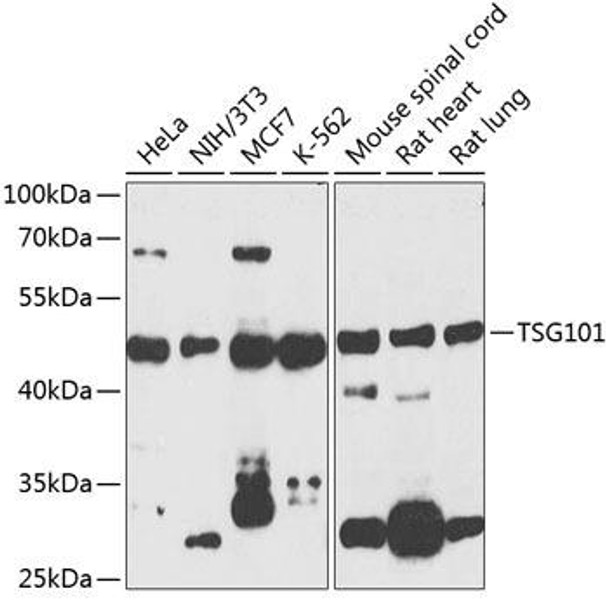Anti-TSG101 Antibody (CAB2216)
- SKU:
- CAB2216
- Product type:
- Antibody
- Reactivity:
- Human
- Reactivity:
- Mouse
- Reactivity:
- Rat
- Host Species:
- Rabbit
- Isotype:
- IgG
- Research Area:
- Cell Cycle
Description
| 抗体名: | Anti-TSG101 Antibody |
| 抗体コード: | CAB2216 |
| 抗体サイズ: | 20uL, 50uL, 100uL |
| 申し込み: | WB IHC IF IP |
| 反応性: | Human, Mouse, Rat |
| 宿主種: | Rabbit |
| 免疫原: | A synthetic peptide corresponding to a sequence within amino acids 300 to the C-terminus of human TSG101 (NP_006283.1). |
| 申し込み: | WB IHC IF IP |
| 推奨希釈: | WB 1:200 - 1:2000 IHC 1:50 - 1:200 IF 1:50 - 1:200 IP 1:20 - 1:50 |
| 反応性: | Human, Mouse, Rat |
| ポジティブサンプル: | HeLa, NIH/3T3, MCF7, K-562, Mouse spinal cord, Rat heart, Rat lung |
| 免疫原: | A synthetic peptide corresponding to a sequence within amino acids 300 to the C-terminus of human TSG101 (NP_006283.1). |
| 精製方法: | Affinity purification |
| ストレージバッファ: | Store at -20'C. Avoid freeze / thaw cycles. Buffer: PBS with 0.02% sodium azide, 50% glycerol, pH7.3. |
| アイソタイプ: | IgG |
| 順序: | SALE KMEN QSEN NDID EVII PTAP LYKQ ILNL YAEE NAIE DTIF YLGE ALRR GVID LDVF LKHV RLLS RKQF QLRA LMQK ARKT AGLS DLY |
| 遺伝子ID: | 7251 |
| Uniprot: | Q99816 |
| セルラーロケーション: | Cytoplasm, Late endosome membrane, Membrane, Nucleus, Peripheral membrane protein |
| 計算された分子量: | 31kDa/43kDa |
| 観察された分子量: | 48kDa |
| 同義語: | TSG10, VPS23, TSG101 / VPS23, TSG101 |
| バックグラウンド: | The protein encoded by this gene belongs to a group of apparently inactive homologs of ubiquitin-conjugating enzymes. The gene product contains a coiled-coil domain that interacts with stathmin, a cytosolic phosphoprotein implicated in tumorigenesis. The protein may play a role in cell growth and differentiation and act as a negative growth regulator. In vitro steady-state expression of this tumor susceptibility gene appears to be important for maintenance of genomic stability and cell cycle regulation. Mutations and alternative splicing in this gene occur in high frequency in breast cancer and suggest that defects occur during breast cancer tumorigenesis and/or progression. |
| UniProt Protein Function: | TSG101: Component of the ESCRT-I complex, a regulator of vesicular trafficking process. Binds to ubiquitinated cargo proteins and is required for the sorting of endocytic ubiquitinated cargos into multivesicular bodies (MVBs). Mediates the association between the ESCRT-0 and ESCRT-I complex. Required for completion of cytokinesis; the function requires CEP55. May be involved in cell growth and differentiation. Acts as a negative growth regulator. Involved in the budding of many viruses through an interaction with viral proteins that contain a late-budding motif P-[ST]-A-P. This interaction is essential for viral particle budding of numerous retroviruses. Belongs to the ubiquitin-conjugating enzyme family. UEV subfamily. 2 isoforms of the human protein are produced by alternative splicing. |
| UniProt Protein Details: | Protein type:Nuclear receptor co-regulator; Cell cycle regulation Chromosomal Location of Human Ortholog: 11p15 Cellular Component: multivesicular body; late endosome membrane; early endosome; cytoplasm; late endosome; plasma membrane; nucleolus; endosome membrane Molecular Function:ubiquitin binding; protein binding; protein homodimerization activity; DNA binding; ubiquitin protein ligase binding; transcription corepressor activity; calcium-dependent protein binding Biological Process: viral reproduction; ubiquitin-dependent protein catabolic process via the multivesicular body pathway; non-lytic virus budding; protein modification process; viral infectious cycle; virus assembly; endosome transport; keratinocyte differentiation; negative regulation of cell proliferation; protein transport; cell division; viral protein processing; regulation of cell growth; cell cycle arrest; negative regulation of transcription, DNA-dependent Disease: Breast Cancer |
| NCBI Summary: | The protein encoded by this gene belongs to a group of apparently inactive homologs of ubiquitin-conjugating enzymes. The gene product contains a coiled-coil domain that interacts with stathmin, a cytosolic phosphoprotein implicated in tumorigenesis. The protein may play a role in cell growth and differentiation and act as a negative growth regulator. In vitro steady-state expression of this tumor susceptibility gene appears to be important for maintenance of genomic stability and cell cycle regulation. Mutations and alternative splicing in this gene occur in high frequency in breast cancer and suggest that defects occur during breast cancer tumorigenesis and/or progression. [provided by RefSeq, Jul 2008] |
| UniProt Code: | Q99816 |
| NCBI GenInfo Identifier: | 5454140 |
| NCBI Gene ID: | 7251 |
| NCBI Accession: | NP_006283.1 |
| UniProt Secondary Accession: | Q99816,Q9BUM5, |
| UniProt Related Accession: | Q99816 |
| Molecular Weight: | 43,944 Da |
| NCBI Full Name: | tumor susceptibility gene 101 protein |
| NCBI Synonym Full Names: | tumor susceptibility gene 101 |
| NCBI Official Symbol: | TSG101 |
| NCBI Official Synonym Symbols: | TSG10; VPS23 |
| NCBI Protein Information: | tumor susceptibility gene 101 protein; tumor susceptibility protein; ESCRT-I complex subunit TSG101 |
| UniProt Protein Name: | Tumor susceptibility gene 101 protein |
| UniProt Synonym Protein Names: | ESCRT-I complex subunit TSG101 |
| Protein Family: | Tumor susceptibility gene 101 protein |
| UniProt Gene Name: | TSG101 |
| UniProt Entry Name: | TS101_HUMAN |





